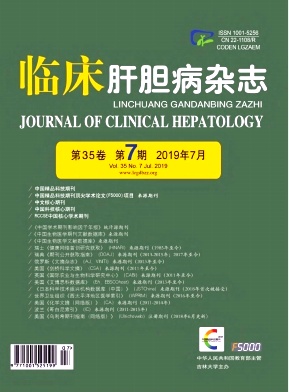|
[1]ZHANG Y, NIE QH.Analysis of complications and death causes of 1892 patients with liver failure[J].J Prac Hepatol, 2014, 17 (2) :129-132. (in Chinese) 张野, 聂青和.1892例肝衰竭患者并发症及死亡原因分析[J].实用肝脏病杂志, 2014, 17 (2) :129-132.
|
|
[2]MOORE JK, LOVE E, CRAIG DG, et al.Acute kidney injury in acute liver failure:A review[J].Expert Rev Gastroenterol Hepatol, 2013, 7 (8) :701-712.
|
|
[3]LI XP, WU ZP, ZHANG LL, et al.Advances in diagnosis and treatment of patients with acute-on-chronic liver failure complicated by acute kidney injury[J].J Clin Hepatol, 2016, 32 (9) :1688-1693. (in Chinese) 李小鹏, 吴振平, 张伦理, 等.慢加急性肝衰竭并发急性肾损伤的诊治进展[J].临床肝胆病杂志, 2016, 32 (9) :1688-1693.
|
|
[4]ANGELI P, GINES P, WONG F, et al.Diagnosis and management of acute kidney injury in patients with cirrhosis:Revised consensus recommendations of the International Club of Ascites[J].J Hepatol, 2015, 62 (4) :968-974.
|
|
[5]GOCEZ I, KOCH M, RENNER P, et al.Urinary biomarkers TIMP-2 and IGFBP7 early predict acute kidney injury after major surgery[J].PLo S One, 2015, 10 (3) :e120863.
|
|
[6] Chinese Society of Hepatology and Chinese Society of Infectious Diseases, Chinese Medical Association.The guideline of prevention and treatment for chronic hepatitis B (2010 version) [J].J Clin Hepatol, 2011, 27 (1) :Ⅰ-ⅩⅥ. (in Chinese) 中华医学会肝病学分会, 中华医学会感染病学分会.慢性乙型肝炎防治指南 (2010年版) [J].临床肝胆病杂志, 2011, 27 (1) :Ⅰ-ⅩⅥ.
|
|
[7] Liver Failure and Artificial Liver Group, Chinese Society of Infectious Diseases, CMA, Severe Liver Disease and Artificial Liver Group, Chinese Society of Hepatology, CMA.Guideline for diagnosis and treatment of liver failure (2012 version) [J].Chin J Clin Infect Dis, 2012, 5 (6) :321-327. (in Chinese) 中华医学会感染病学分会肝衰竭与人工肝学组, 中华医学会肝病学分会重型肝病与人工肝学组.肝衰竭诊治指南 (2012年版) [J].中华临床感染病杂志, 2012, 5 (6) :321-327.
|
|
[8]RUIZDEL AL, MONESCILLO A, AROCENA C, et al.Circulatory function and hepatorenal syndrome in cirrhosis[J].Hepatology, 2005, 42 (2) :439-447.
|
|
[9]ARROYO V, FERNANDEZ J.Management of hepatorenal syndrome in patients with cirrhosis[J].Nat Rev Nephrol, 2011, 7 (9) :517-526.
|
|
[10]PARIKH CR, MISHRA J, THIESSEN PH, et al.Urinary IL-18is an early predictive biomarker of acute kidney injury after cardiac surgery[J].Kidney Int, 2006, 70 (1) :199-203.
|
|
[11]DUAN ZH, REN MX, ZHU XM, et al.Predictive value of urinary kidney injury molecule-1 on clinical curative effect of liver cirrhosis patients with acute kidney injury[J/CD].Chin J Liver Dis:Electronic Edit, 2017, 9 (4) :63-68. (in Chinese) 段忠辉, 任美欣, 朱学敏, 等.尿肾损伤分子-1对肝硬化合并急性肾损伤患者临床疗效的预测价值[J/CD].中国肝脏病杂志:电子版, 2017, 9 (4) :63-68.
|
|
[12]CHERTOW GM, BURDICK E, HONOUR M, et al.Acute kidney injury, mortality, length of stay, and costs in hospitalized patients[J].J Am Soc Nephrol, 2005, 16 (11) :3365-3370.
|
|
[13]ZHUANG Y, XIE Q.Advances in research hotspots in liver failure complicated by acute kidney injury[J].J Clin Hepatol, 2018, 34 (9) :1836-1841. (in Chinese) 庄焱, 谢青.肝衰竭并发急性肾损伤热点研究新进展[J].临床肝胆病杂志, 2018, 34 (9) :1836-1841.
|
|
[14]LIU YD, XING YF.Research progress and application evaluation of markers for acute kidney injury[J].China Med Herald, 2018, 15 (18) :32-35. (in Chinese) 刘亚东, 邢延芳.急性肾脏损伤标志物的研究进展及应用评价[J].中国医药导报, 2018, 15 (18) :32-35.
|
|
[15]SEO DW, LI H, QU CK, et al.Shp-1 mediates the antiproliferative activity of tissue inhibitor of metalloproteinase-2 in human microvascular endothelial cells[J].J Biol Chem, 2006, 281 (6) :3711-3721.
|
|
[16]GOMEZ H, INCE C, DEBACKER D, et al.A unified theory of sepsis-induced acute kidney injury:Inflammation, microcirculatory dysfunction, bioenergetics, and the tubular cell adaptation to injury[J].Shock, 2014, 41 (1) :3-11.
|
|
[17]SEO DW, KIM SH, EOM SH, et al.TIMP-2 disrupts FGF-2-induced downstream signaling pathways[J].Microvasc Res, 2008, 76 (3) :145-151.
|
|
[18]MEERCH M, SCHMIDT C, VAN AH, et al.Urinary TIMP-2and IGFBP7 as early biomarkers of acute kidney injury and renal recovery following cardiac surgery[J].PLo S One, 2014, 9 (3) :e93460.
|
|
[19]KASHANI K, AIKHAFAJIA, ARDILES T, et al.Discovery and validation of cell cycle arrest biomarkers in human acute kidney injury[J].Crit Care, 2013, 17 (1) :r25.
|







 DownLoad:
DownLoad: